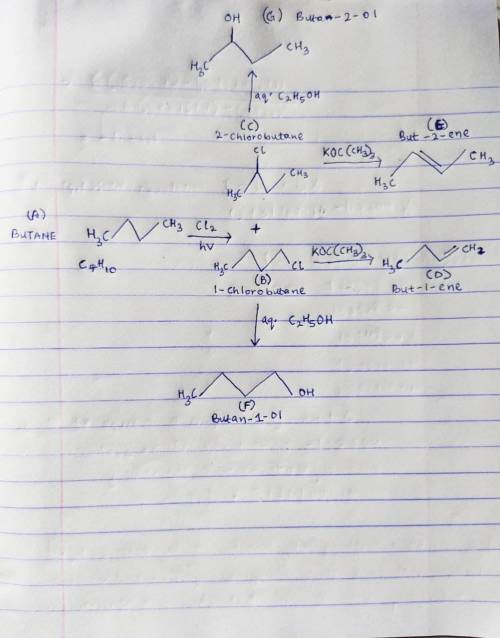
Chemistry, 25.06.2021 04:10 gunnatvinson
Compound A has molecular formula C4H10. Compound A gives two monochlorides, B and C, on photochemical chlorination. Treatment of either of these monochlorides with potassium tert-butoxide gives the same alkene (C4H8) as the product, but B leads to just one isomer of the alkene, D, whereas C gives D and another isomer of the alkene, E. Treatment of monochlorides B and C with aqueous ethanol gives products F and G, respectively, both of which are of molecular formula C4H10O. What are the chemical names of compounds A-G

Answers: 3
Another question on Chemistry

Chemistry, 22.06.2019 20:00
Nitrogen dioxide decomposes according to the reaction 2 no2(g) ⇌ 2 no(g) + o2(g) where kp = 4.48 × 10−13 at a certain temperature. if 0.70 atm of no2 is added to a container and allowed to come to equilibrium, what are the equilibrium partial pressures of no(g) and o2(g)
Answers: 2

Chemistry, 22.06.2019 22:30
Which of the following molecules is polar? c3h7oh c2h5cooh
Answers: 1

Chemistry, 22.06.2019 22:30
Calculate the concentration of all species in a 0.165 m solution of h2co3.
Answers: 1

You know the right answer?
Compound A has molecular formula C4H10. Compound A gives two monochlorides, B and C, on photochemica...
Questions






Medicine, 18.11.2020 07:40


Mathematics, 18.11.2020 07:40

Mathematics, 18.11.2020 07:40

Mathematics, 18.11.2020 07:40


Advanced Placement (AP), 18.11.2020 07:40

Chemistry, 18.11.2020 07:40

Biology, 18.11.2020 07:40

English, 18.11.2020 07:40

Mathematics, 18.11.2020 07:40


Mathematics, 18.11.2020 07:40


Chemistry, 18.11.2020 07:40




